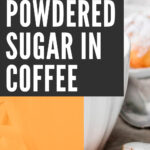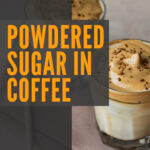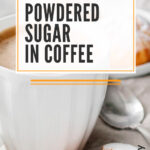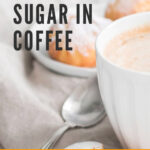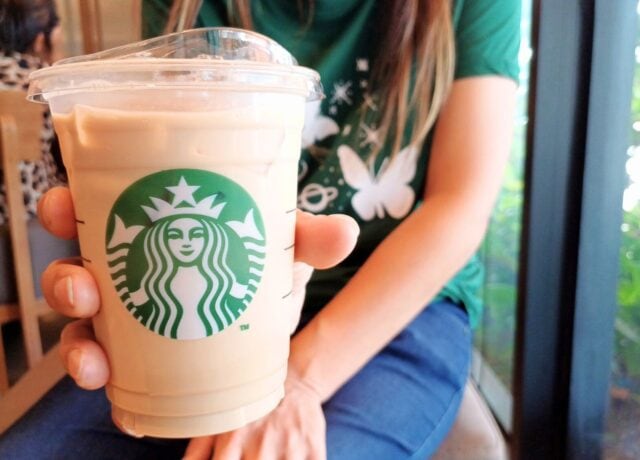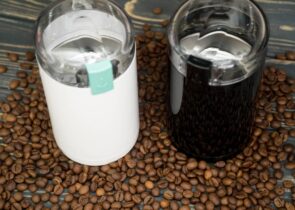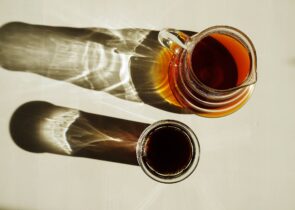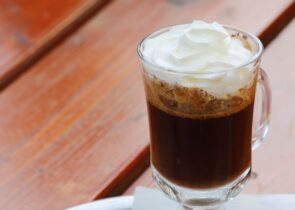If you are a coffee lover and you have a cup (or several) a day, you have probably tried many different sweeteners in your time. Usually, white granulated sugar is the traditional choice. You have probably come across a situation where you’ve made your morning coffee, and then you suddenly realize you’re out of sugar.
Not a fan of black coffee? What can you do? Do you randomly have a bag of powdered sugar lying around? Will that work?
The short answer is yes, it can. But how much do you use, and how will it work? Read on to find out more about sugar in your coffee and how to use powdered sugar when you’re in a pinch or want something different.
Traditional Granulated Sugar
As mentioned in our article about the best sugar for coffee, white sugar, which you may know as table sugar, or simply what you think of when you hear “sugar,” is the regular sugar people use to sweeten their cup of coffee.
While you can add granulated sugar to coffee, it is also available in cube form and is often the main ingredient for different coffee syrups. As with most sugar, you will end up with a lot of extra calories if you use it to sweeten your coffee. For example, as the sweetener article mentions, one hundred grams of white sugar equals 387.2 calories.
How about Brown sugar?
Brown sugar is made by adding molasses to white sugar. The more molasses, the darker the sugar, hence light brown or dark brown sugar. Its calorie count is slightly less than white sugar, but there is no scientific proof that brown sugar is healthier or has more nutritional value.
Why Choose Powdered Sugar Instead of Granulated Sugar?
Powdered sugar and granulated sugar are actually the same. The difference is that granulated sugar has larger particles or granules. If you blend up table sugar in a food processor, you will end up with powdered sugar.
One benefit of powdered sugar is that it disintegrates into your hot coffee faster and can even make the coffee slightly smoother. You’re also likely to have some powdered sugar on hand if you’re a big baker. If you have it stocked in your kitchen already, it saves you the hassle of buying different sugars for your baking and your coffee.
You will need a quarter cup of powdered sugar to produce the same taste as two tablespoons of granulated sugar. So you will always need more powdered sugar to sweeten your coffee the same way you do when using table sugar.
Ways to Use Powdered Sugar in Coffee
So you have to use more of it, and it’s basically the same thing? Okay, maybe you’re not convinced that powdered sugar is the way to go for coffee. But it actually has some uses for coffee that are pretty delicious!
Read below to find out how to replace granulated sugar with powdered sugar, as well as some easy (and, of course, tasty) recipes you can make at home and enjoy.
Use as a Replacement for Regular Sugar
As mentioned above, you can absolutely replace granulated sugar with powdered sugar, but you must be sure to get your ratios right. Remember that a quarter cup of powdered sugar is equivalent to two tablespoons of granulated sugar. Enjoy the same sweetness with a softer texture.
All you have to do is brew your usual cup of coffee, measure your powdered sugar to your preferred sweetness and add anything else you usually put in your coffee. Easy as that.
Make Some Dalgona (Whipped) Coffee

Whipped coffee, as it has been recently dubbed in the internet trend that took over the world, is normally called Dalgona coffee. And while it has been used in parts of the world for a long time, now it has reached global fame for its amazing texture and delicious flavor.
The good news is, you can use powdered sugar in Dalgona coffee recipes for that perfect fluffy cup of tastiness.
To make Dalgona coffee, you will need:
- 4 tablespoons of powdered sugar
- 2 tablespoons of instant coffee
- 2 tablespoons of cold water
- 1 medium-size bowl
Whisk the ingredients together (and take note, this does take quite some time if you’re whisking it by hand) until you reach the desired smooth and silky texture. Continue to whisk it until it becomes fluffy and foamy, kind of like whipped cream.
Once you’ve reached that texture, take a glass, fill it with ice and milk, and then put the whipped coffee on top. You can choose to let it stay on top of the milk and ice or blend it into the drink.
Make a Coffee Drizzle Glaze
While this recipe differs from a simple cup of coffee or a trendy Dalgona whip, this coffee glaze is perfect for adding to your favorite breakfast or dessert, and, of course, powdered sugar is a key ingredient.
To make it, use:
- 1 cup of powdered sugar
- 1 1/2 tablespoons of coffee (strong brewed is preferred)
Whisk the two ingredients together in a bowl until the texture of the mix is smooth. And that’s all! You can use this simple glaze on pastries or other types of dessert to give your sweets a nice coffee kick.
Final Thoughts
We all know that sugar is a great thing. It gives us the sweetness we all need in coffee, other drinks, and sweet foods. However, for the sake of your health, make sure not to overdo it with your sweetener.
Since coffee is naturally bitter, it makes sense to sweeten it up a little, and powdered sugar in coffee works just as well as granulated. Don’t be afraid to use it to sweeten your cup or to make others feel guilty if they’re not drinking their coffee black.
Feel free to try these methods using powdered sugar and enjoy yourself while doing your best to remain healthy with your coffee routine.
Happy Caffeinating!

